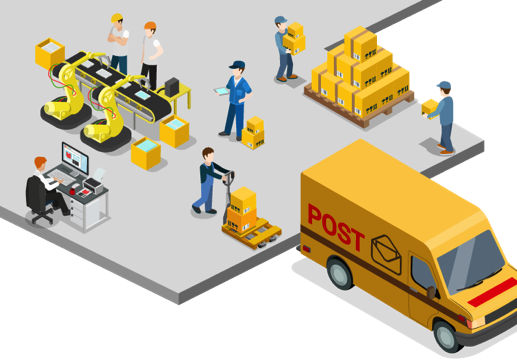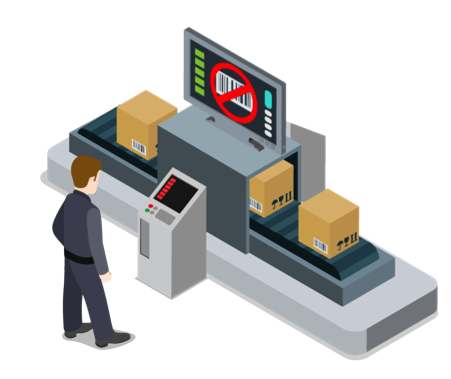How To Reduce Supplier Inventory Costs
By John Kelser, Loftware Senior Sales Engineer
Move Inventory Faster – It Starts with a Label 
If you’re like most large manufacturers, the management of supplier goods is a complex process with multiple stakeholders. You have Planning that drives forecast and production scheduling, and Procurement that purchases materials from vendors based on those demand forecasts. Operations oversees the flow of incoming goods in the production line, and then Warehouse Management receives inbound shipments and moves them into inventory until ready for use. While the titles and roles may vary among organizations, the basic supplier workflow is generally the same.
Where it gets messy—and where you are likely to experience significant costs in time and money—is the physical handoff from your supplier. Essentially, when the box hits the dock. All too often we see a reliance on the Advanced Shipping Notice (ASN) in which the supplier alerts you of pending deliveries at the header level. You may see a product name, a PO#, and select dates, but the ASN does not contain many of the details that receiving or warehouse management needs, such as pallet breakdown. Then there are the labels themselves on the pallets and boxes, which were created by the supplier with no certainty that they are correct or aligned with your downstream process and data.
That’s why it’s not unusual to see pallets and pallets of supplier goods stacked up in receiving waiting to be sorted out and relabeled. If things go right, you or a 3PL partner will spend several days creating and printing new labels, which drives the need for additional buffer inventory. You can end up spending hundreds of thousands, even millions of dollars reconciling supplier goods and driving up inventory costs. Ask yourself this: If it takes weeks for supplies to travel thousands of miles from Asia to your dock, why does it take another several days for the same supplies to move a few hundred feet to be properly processed for your operation?
There is a better way…and it points to the label. Think about it; the label connects the supplier’s intent to your ERP and, equally important, to the part itself. What if you could control the labeling outside your four walls so that shipments from suppliers and other trading partners were labeled with the information you required? Your data, your barcodes, your instructions, your process?
Thanks to new advancements in browser-based enterprise labeling, you can make this a reality. By using data directly from your ERP and merging it with supplier actions, you ensure that inbound materials are labeled and formatted the right way—your way, securely. In addition, you can track goods with unprecedented visibility to respond faster and smarter to fluctuations in supply and demand.
Extend Enterprise Labeling to Suppliers 
Thousands of manufacturers across multiple industries are already relying on enterprise labeling to drive measurable gains within their “four walls.” The tight integration with existing enterprise applications like ERP, PLM, WMS, and other systems ensures that the data on the label is the most current and enables companies to automate the labeling process within these applications. By standardizing and centralizing on a single labeling platform, companies can share templates among internal teams to simplify the approval workflow, reduce the number of templates to manage, and keep up with changing requirements without duplicating efforts.
Now imagine simply extending your labeling process to include your trading partners such as suppliers and 3PLs. Thanks to breakthrough, browser-based technology, you can allow suppliers to securely access, update, and print your labels locally with the exact information and data your downstream process requires. And because the data is coming directly from your ERP and other sources of truth, you can be confident that the label will capture the latest information in real time.
Importantly, from an implementation and execution phase, there’s minimal effort required of your suppliers. They have to create and print pallet and carton labels anyway; now they simply print your labels in your format. In addition, this new approach to supplier labeling complements and greatly enhances the existing ASN/EDI process they’re currently using by sharing valuable data that can be cross-referenced on the ASN. They can even leverage the label data to help create the ASN.
The short- and long-term benefits of this approach are many.
- Eliminate relabeling, once and for all. First and foremost, when you push labeling to your suppliers using your data, your instructions, your downstream processes—even your branding—you avoid costly relabeling altogether. This alone has saved some companies upwards of $2M - $3M in labor and materials.
- Increase velocity of inbound receiving. Now you can move product from dock to stock in record time. No more confusion or uncertainty when supplier shipments arrive. You also help limit the number of cycle counts and inspections required by warehouse management or operations. This leads to an even greater benefit…
- Reduce inventory, achieve JIT goals. Because you can eliminate delays in receiving (not to mention labeling errors) and move materials swiftly as part of your downstream process, you don’t need to store as much buffer or safety stock. If you reduce the required inventory by just a shift or two, you could save millions in warehousing costs.
- Know when supplies are coming earlier, plan accordingly. From a planning and receiving perspective, you now have visibility into when labels are printed by the supplier to better estimate arrival of goods—even before the ASN. As you gain insight into supplier behavior based on how and when they use your templates, you can revise safety stock calculations to reduce inventory even more. Visibility equals confidence equals reduced stocking levels.
- Respond faster to course corrections in manufacturing. As needs change in operations, you can actually push and pull supplier orders to adjust the delivery schedule. Say, for example, you have a sudden shortage of a certain part as reflected in the ERP, and you notice that the supplier hasn’t printed labels yet. You can alert them, add to the order if needed, and even put special instructions on the label for receiving to rush the parts to production. Calls to the suppliers can be more precise allowing execution to begin sooner.
- Prioritize orders, keep suppliers in check. With enterprise labeling, you can start injecting control over how the supplier is managing transactions. Set up rules that enable a supplier to only print labels tied to a particular time fence. This helps prevent a supplier from dumping inventory at the end of the year. You can also FIFO the PO’s. No more “cherry picking” POs by suppliers.
- Visibility of suppliers, big and small. The secure push of labels greatly benefits how you work with smaller suppliers that don’t use an ASN/EDI process. Procurement, Planning, and Warehouse Management can have one view into inbound shipments without using cumbersome faxes, spreadsheets and other methods.
- Gain insight into supplier carrier costs. With enhanced visibility into supplier labels and their shipping methods, you can see which orders were expedited. Was that your request or the supplier’s? Now you have the proof to reconcile any transportation costs associated with delays on their end.
Also, because you design and own all the supplier labels—from the carton to the pallet to the truck—you have granular detail where your materials are every step of the way. This helps you adopt a management by exception process for more precise control based on your specific needs.
So, rather than putting the burden on the supplier to adopt cumbersome label guidelines or new technology that may or may not fit with their process (or budget), why not take back control and provide them with the accurate labels and data you need when they’re ready to ship—easily and securely? New innovations in enterprise labeling make it faster and easier to produce labels at your suppliers and other partners to ensure accuracy, eliminate relabeling, and reduce dock-to-stock time. And that’s just for starters.

By John Kelser, Loftware Senior Sales Engineer
John Kelser is a Senior Sales Engineer with Loftware and has twenty years of experience in systems design, development, implementation and maintenance, as well as project management of large-scale initiatives with global reach in e-Business, finance and telecommunications.
More articles :
